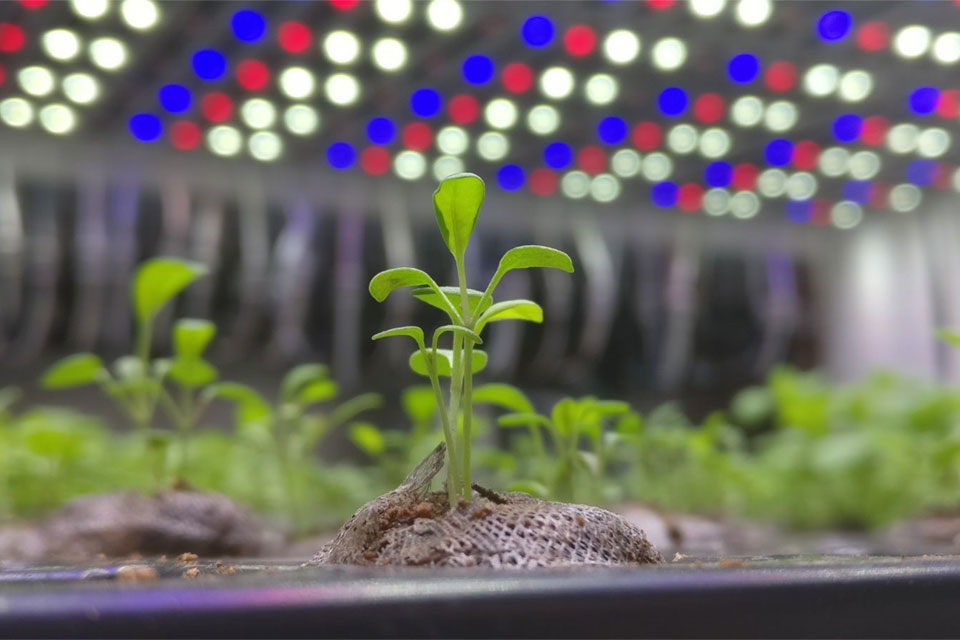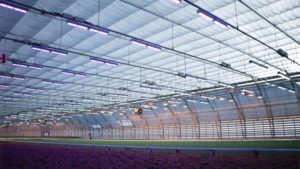Solving Greenhouse Lighting Issues With New Research and Innovation

Philips Lighting LED trials of arugula to increase vitamin C content at the GrowWise Research Center. Photo courtesy of Philips Lighting
With an abundance of research in the lighting world, it is imperative that you keep up with the latest information. Whether you are retrofitting an old lighting system or installing a new one, there is always a learning curve.
When a change occurs in light quality, intensity, or both, other variables may change, as well. Consider, for example, that switching over to light-emitting diode (LED) lighting could reduce the amount of heat emitted, potentially reducing water requirements. Less heat could also mean necessary bottom heat during seasons that didn’t previously require it. Furthermore, LED lighting often does not include the same spectrum as other lighting, so fertilizer requirements could change.
It is important to keep in mind when planning that LEDs are not a one-to-one replacement for high-pressure sodium lights (HPS), as the spectrum and light intensity are much different, says Ron DeKok, Director of North America-Horticulture LED Solutions for Philips Lighting. Although many of the new digital-control systems are user-friendly, the learning curve still exists.
“It’s all about the research you put into your purchase; not all light sources are suitable for all applications,” says Chris Pieser, President and CTO of Chameleon Plasma Grow Lighting. “It’s important to work with a company that will stay by your side every step of the way, from planning for your specific needs to growing and evaluating your results, and beyond. Also, do your own personal research and talk with others in the industry to gain knowledge.”
Light uniformity is also critical to ensure evenness of crop growth, height, and flowering, and also to allow consistent watering across the greenhouse, says Erin Sharp, Business Development Director in North America for Valoya.
Commercial light suppliers can provide a lighting design for your greenhouse, along with a light map that shows uniformity on the plant canopy, she says. But beware, because not all manufacturers are upfront on how they design this, as they may not provide your crop with sufficient uniformity.
Professional Advice to Work Through Your New Lighting Strategies
“There’s nothing wrong with starting small,” says Drew Koschmann, Head Grower at Walters Gardens.
After seeing the promising results of its small LED trials, Walters expanded into a larger production setting, and has seen great improvements in finishing times, growth consistency, and better branching and rooting, as compared to its HPS fixtures.
Ron James, Managing Director of PARsource, says he recommends working with a lighting manufacturer that sells a variety of lighting types. This allows the grower to purchase the best type of lighting technology for his or her specific needs. Additionally, always take into account what crops you grow and in what climate, to select the lighting options most suitable for your operation.
You can also take advantage of lighting companies’ research and development teams. For example, LumiGrow’s research and development team consults with specialists in the industry to develop specific protocols for its customers that are based on each grower’s individual space, control systems, and goals.
An often overlooked but important task of lighting systems is maintenance. P.L. Light Systems is big on keeping its lamps in top shape to ensure optimal output and longevity. It also helps its customers be successful by educating them on how to clean reflectors, replace lamps, and maintain their lights to keep them working efficiently.

Fluence VYPRx PLUS lighting with custom spectra is being used to increase anthocyanin content in red lettuce on the left, while Fluence VYPRx PLUS with Physiospec broad-spectrum lighting is being used on the right to encourage full-cycle plant growth. Photo courtesy of Travis Williams.
Recent Developments and Trials in Lighting Research
“The advancements in photobiology research and LED technology are moving together at a rapid pace,” says Travis Williams, Vice President of Marketing, Fluence Bioengineering, which is studying the effects of spectra on water use and nutrient-use efficiency, as well as how spectrum influences root development and internode spacing.
With new control softwares, it is possible to control crop cycles, morphology and composition, yields, operating costs, and company profits.
“The new Cortex system from Heliospectra applies machine learning to predict, create, and dynamically correct light schedules based on actual light conditions in a greenhouse,” says Caroline Nordahl Wells, General Manager, Americas, at Heliospectra.
The system allows growers to only use the supplemental light they need and decreases the amount of time spent adjusting other systems.
Valoya is doing extensive research on the spectral effects on cannabis growth, concentrating on the morphological features, such as plant height, branching, plant size (dry weight), and leaf and flower biomass, as well as the chemical analysis from the flowers. Its focus is to find the optimal growth spectrum to have the type of plant the grower is after; whether they are looking for the largest possible plant with high biomass or a small and slim plant ideal for vertical farming. For flowering, Valoya wants to provide solutions that will specifically enhance the cannabinoid yield and consistency throughout the crop.
Universities are working together on lighting research, to look at plant responses and what manipulations can be made to increase production and reduce costs. Neil Mattson, Associate Professor and Greenhouse Extension Specialist at Cornell University is working with A.J. Both, an Associate Extension Specialist at Rutgers University, to determine the Parabolic Anodized Reflector (PAR) efficacy of HPS and LED fixtures by comparing the performance of leafy greens in a greenhouse environment.
Researchers are also studying the interactions between carbon dioxide enrichment and the reduction of supplemental lighting. Using microgreens, Mattson says they have seen that increasing carbon dioxide from 400 ppm up to 1,000 ppm in the greenhouse can reduce lighting costs by 25%.
Philips’ GrowWise Research Center in Eindhoven, Netherlands, collaborated with Dutch Wageningen University and Research, as well as Maastricht University, to develop a new growth protocol to increase vitamin C content in arugula. These trials were conducted using Philips LED lighting with no daylight in a vertical-farming environment. Results show up to seven times more vitamin C using this developed growing recipe, which is one of the markers needed for good shelf life.










